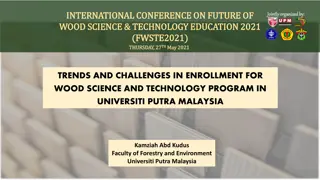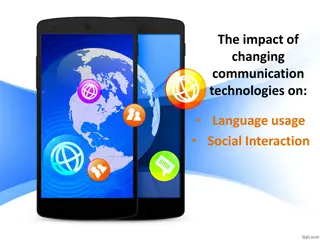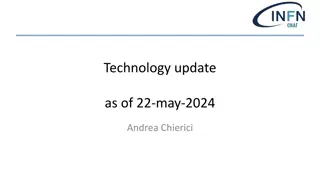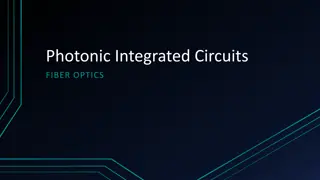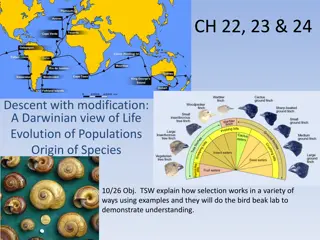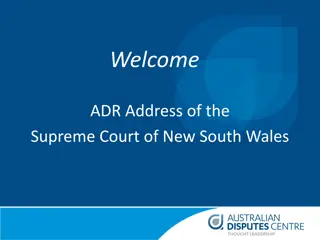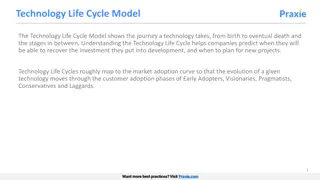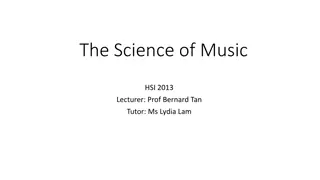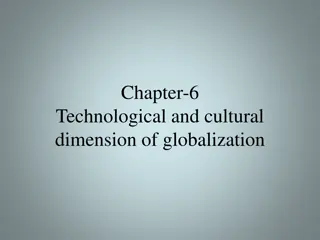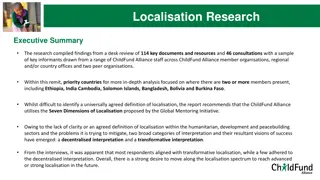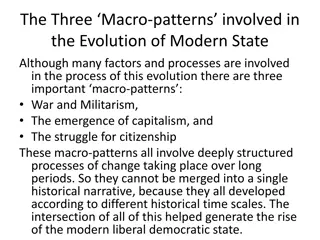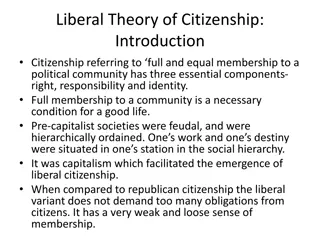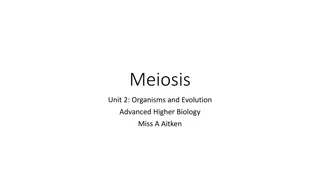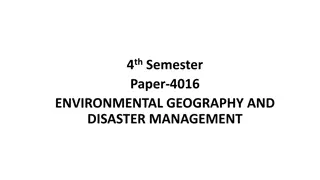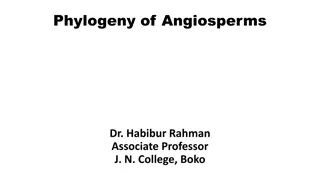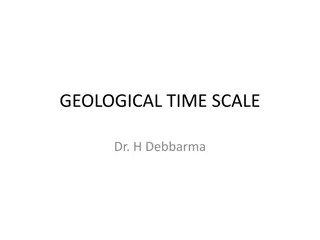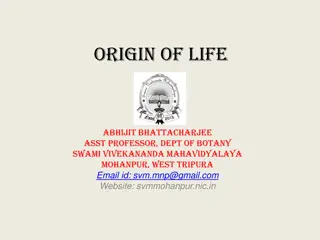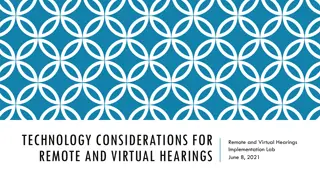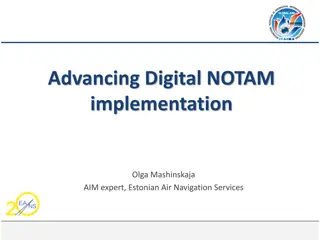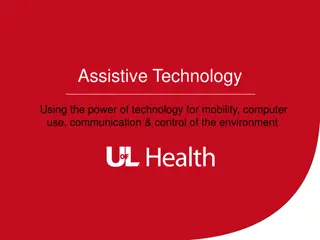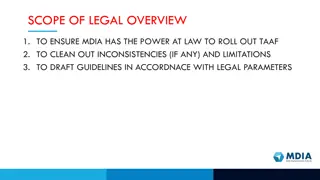Evolution and Impact of Wi-Fi Technology Trends
Discussion on the next generation Wi-Fi technology evolution, target objectives, and requirements aligning with market needs. The presentation covers the evolution of Wi-Fi technology based on requirements from 1997 to 2023, emphasizing the increasing importance of Wi-Fi due to global trends during the COVID-19 pandemic, showcasing significant growth in Wi-Fi usage and traffic.
Download Presentation

Please find below an Image/Link to download the presentation.
The content on the website is provided AS IS for your information and personal use only. It may not be sold, licensed, or shared on other websites without obtaining consent from the author. Download presentation by click this link. If you encounter any issues during the download, it is possible that the publisher has removed the file from their server.
E N D
Presentation Transcript
May, 2022 doc.: IEEE 802.11-22/685r0 Discussion on next generation Wi-Fi Date: 2022-05-09 Authors: Name Affiliations Address Email LG Seocho R&D Campus, Korea Jinsoo Choi js.choi@lge.com Eunsung Park Insun Jang Dongguk Lim LG Electronics Jinyoung Chun Insik Jung Sunhee Baek Sang Kim HanGyu Cho Submission Slide 1 Jinsoo Choi, LG Electronics
May, 2022 doc.: IEEE 802.11-22/685r0 Abstract This presentation : discusses thoughts on direction and target objectives for the next generation Wi-Fi Submission Slide 2 Jinsoo Choi, LG Electronics
May, 2022 doc.: IEEE 802.11-22/685r0 Instruction In preceding IEEE 802.11 WNG sessions, there were contributions for discussion on next mainstream Wi-Fi evolution [1]~[6] The next Wi-Fi targets development at 2028~ (similar with 6G at 2030) The goal should be aligned with market needs and essential applications around those timeline In our view, this is good time to start the discussion on where our Wi-Fi technologies are now, and what requirements should be considered for the future use cases Submission Slide 3 Jinsoo Choi, LG Electronics
May, 2022 doc.: IEEE 802.11-22/685r0 Wi-Fi technology evolution by requirements 2019 2014 2008 2023 1997 Max 9.7Gbps 4x STA Tput, Congestion/Power Max > 30Gbps (23Gbps per link) Extremely high Tput, Low latency Max > 11be Gbps ? Tput, Latency, Reliability ? Max 600Mbps Single STA Tx Max 6.9Gbps Multi-STAs Gigabit Wi-Fi 28~ 802.11a/g/n 802.11ac Next Wi-Fi (Wi-Fi 8) 802.11ax (Wi-Fi 6) 802.11be (Wi-Fi 7) DL/UL OFDMA DL/UL MU-MIMO (~8 SS) 320MHz, 6GHz 4096-QAM Longer symbol Triggered access/TWT Multi-link aggregation/operation r-TWT, Triggered P2P OFDM MIMO (~4 SS) 40MHz 64-QAM DL/UL OFDMA DL/UL MU-MIMO (~8 SS) 160MHz, 6GHz 1024-QAM Longer symbol Triggered access/TWT OFDM DL MU-MIMO (~8 SS) 160MHz 256-QAM OFDM SISO 20MHz 64-QAM Baseline 11be + 11be R2 candidate features e.g. 16-SS, Multi-AP, HARQ, ML, + New features Will discuss later More BW , Larger Nss , Higher MCS Enabling simultaneous transmission of Multiple STAs data Extended symbol length , Triggered access/wake-up Link Agg , LST prioritization , P2P handling The technologies have been improved based on the target requirements from market needs, and this evolution will continue for the next Wi-Fi (Wi-Fi 8) Submission Slide 4 Jinsoo Choi, LG Electronics
May, 2022 doc.: IEEE 802.11-22/685r0 Trends throughout global pandemic : Increase of Wi-Fi usage and areas Much higher upload traffic and created mostly by laptops and PCs Global Wi-Fi traffic grew by 80% (Dec 2019 ~ April 2020) Simultaneous Wi-Fi connections: 30% to 40% increase Wi-Fi use in work hour: 70% to 94% increase 9am 5pm Wi-Fi data consumption: 62% increase per home per day Active online users during the workday Daily online home activity surged by 82% (before Covid-19 ~ April 2021) Active home Wi-Fi devices: 50% to 90% increase Active online Wi-Fi users: 82% average increase Video conferencing traffic: >300% increase Feb to Oct 2020 Wi-Fi became essential for many areas that calls for resilience from pandemic Free Wi-Fi for public hotspot, healthcare facilities, school/libraries Enabler of digital transformation: Business processes related to supply chain management (e.g. purchasing, logistics, etc.) with automation, robotic systems and other advanced digital technologies Telehealth: A meteoric rise of visiting healthcare providers virtually by continuing impact from Covid-19 pandemic Mostly the remote work/education, and the utilization of reality experience of virtual world with the untact trend have been accelerated during the pandemic Whenever/wherever reliable and fast Internet connectivity becomes more important to leverage this direction No doubt Wi-Fi can do a key role here Immersive reality experience as well as high quality of connection and data delivery will importantly drive the next Wi-Fi * Source: Wi-Fi Alliance Wi-Fi role in the COVID-19 pandemic (2021 April), Telecom advisory services Covid-19 and the economic value of Wi-Fi Submission Slide 5 Jinsoo Choi, LG Electronics
May, 2022 doc.: IEEE 802.11-22/685r0 Future trends around 2030 envisioned by 6G [7] [14] AR/VR/MR AI driven applications Holographic Telepresence Edge computing Jointly optimized protocols by AI for resolving complex, non-linear impacts System capacity > 1Tbps (Gbps per user) for non-compressed real-time user interactions Joint network and computing resource scheduling, flexible addressing, fast routing ~4.32 Tbps, Sub-ms latency for truly immersive 3D experience 6G prepares technologies supporting for various use cases by aiming extreme KPIs Tactile/Haptic Internet Unmanned mobility E-health (Telediagnosis/surgery) Industry 4.0, Robotics 1ms or Sub-ms (instantaneous haptic feedback) latency Fully autonomous transportation with 99.99999% reliability 99.999% reliability for continuous connection, Sub-ms latency ~100us (per communication link) or 1ms (round-trip reaction) latency Submission Jinsoo Choi, LG Electronics Slide 6
May, 2022 doc.: IEEE 802.11-22/685r0 Use cases achievable by Wi-Fi From our point of view, it is important to categorize the interested scenarios that we pursue for improvement by future Wi-Fi and check what requirements actually need to be considered Wi-Fi signal is mainly designed for fixed or pedestrian target, and the protocol is based on the medium contention in general (while we re improving this) So, such use cases like unmanned mobility, or a certain e-health application with ~100% reliability (i.e. continuously seamless connection) might not be reasonable target [1]~[6] showed good high level insights from multiple members Potential usages such as AR/VR, hybrid work model, coverage extension, roaming/mobility improvement, P2P links management, AI, etc. Envisioning requirements ( may need to be quantified for the PAR later ) 2x 11be or hundred Gbps, 10Gbps on client, 1ms or 0.1ms latency, enhanced reliability/ manageability, and extended coverage, etc. In following slides, we discuss interested use cases from our aspect and potential objectives to be improved by future Wi-Fi Submission Slide 7 Jinsoo Choi, LG Electronics
May, 2022 doc.: IEEE 802.11-22/685r0 Enjoy immersive Metaverse/eXtended Reality experience AR/VR/MR, Hologram/Tactile applications Environment Smart home, Game zone, Construction/Real estate, Shopping, e- health, etc. Potential improvement by future Wi-Fi Wi-Fi that may have more BW/Nss or Multi-link (ML) aggregation provides further extremely high data rate E.g. Future Tput can be further improved by >320MHz BW (depending on regulation in 6GHz) or >8 Nss, or seeking more bands by ML aggregation (w 60GHz if needed (FFS)) Deterministic operation for ML, rTWT or time- sensitive EDCA function will provide further guaranteed low latency (also potentially collaborating with TSN functions) for the truly immersive extended reality or mission critical applications Requirements High Throughput ~100Gbps (peak) Low Latency 1ms or Sub-ms - Being deterministic is key Submission Slide 8 Jinsoo Choi, LG Electronics
May, 2022 doc.: IEEE 802.11-22/685r0 Reliable connectivity for Remote work, e-Education Teleconference/Webinar, e-learning, Remote counsel Environment Hybrid/virtual office (Home), Classroom, etc. Potential improvement by future Wi-Fi Wi-Fi with improved user throughput will be helpful for sharing high quality of images or video streaming at client side (e.g. Laptop/PCs), and good interference mitigation protocol can serve constantly stable Wi-Fi performance with plenty of concurrent users E.g. Client Tput enhancement [3], Spatial reuse protocol (11ax/11be) extension With multi-APs that may help managing operation of multiple users and improve the signal strength, and enhanced link adaptation (e.g. HARQ, finer MCSs), the service coverage can be extended more widely to cover the whole area, importantly with required data rate Requirements High Throughput Improved user(Non-AP STA) data rate - Stable performance at client side Reliable Connectivity Fast/seamless/secure connection Extended coverage Submission Slide 9 Jinsoo Choi, LG Electronics
May, 2022 doc.: IEEE 802.11-22/685r0 Highly managed Wi-Fi by better handling on P2P links P2P: Display mirroring, HMD to phone (/controller), Data sharing Environment Smart home, Game zone, Enterprise/Industrial network, Hotspot, etc. Potential improvement by future Wi-Fi Where multiple P2P links are communicating near the target devices, Wi-Fi that has the protocol to schedule P2P communication, particularly improved by coordinating multiple P2P links, can provide highly managed Wi-Fi performance to target devices E.g. Triggered/centralized multiple P2Ps Dedicated link, or semi-static/persistent channel allocation may be helpful for alleviating the impact from interfering links to target applications such as latency sensitive traffics Target services Requirements High manageability Centralized multiple P2P links control - Minimizing interference to high quality of target services Submission Slide 10 Jinsoo Choi, LG Electronics
May, 2022 doc.: IEEE 802.11-22/685r0 Disruptive technologies for challenging use cases AI (Intelligent Capability) AI-powered Wi-Fi can provide functions optimization/lightening in many complex and non-linear areas Proper planning on traffic forecasting, channel access/congestion control, BW/buffer mgmt. based on the predicted traffic and better load balancing can improve latency and QoS Best MCS/Nss, RU/MRU, BF/MU-MIMO users can be selected, and interference level can be predicted by jointly optimizing the Tx power and channel allocation policies for increasing throughput We expect that AI will provide a key role in achieving challengeable KPIs, e.g. 1ms latency, ~100% reliability How to realize these improvements in 802.11, i.e., impact on PHY & MAC amendments should be discussed further FDR (Simultaneous Tx and Rx) 3GPP 5G (Rel-18) adopted FD as SI for the purpose of duplex enhancement (first focusing on subbands FD) IEEE 802.11be started to develop Multi-link STR which enables simultaneous Tx and Rx for similar purpose, i.e. FDR was already realized by extending its domain to multiple band/link other than In-band Next Wi-Fi may improve this further, for helping latency, (average) throughput requirement E.g. alleviating the strict rule on Multi-link STR (or extending capability of Multi-link Non-STR close to STR) In-band application of FDR will need more intensive investigation on its feasibility/competitiveness (FFS) Study group discussion needs to take into account the feasibility and ways to realize these kinds of disruptive technologies with challengeable KPIs in mind Submission Slide 11 Jinsoo Choi, LG Electronics
May, 2022 doc.: IEEE 802.11-22/685r0 Target objectives for next generation Wi-Fi We propose to keep the improvement of throughput and latency in next generation, which is promisingly indicated by use cases at the timeline we target ~100Gbps (peak) or Improved user (client) Tput 1ms or Sub-ms latency Direction on objectives to pursue, e.g. peak or client Tput, level of worst case latency need further discussion Objectives of reliable connectivity, high manageability are good candidates to be included as new terms of the future Wi-Fi, but These objectives haven t explicitly targeted and quantified in the PAR of previous mainstream Wi-Fi standards, so how to capture the requirements in the scope of new project is important and needs more investigation/discussion before TG Early start of the SG discussion (e.g. at July) is helpful for this purpose Submission Slide 12 Jinsoo Choi, LG Electronics
May, 2022 doc.: IEEE 802.11-22/685r0 Conclusion It is important to target and develop the technologies for what the future Wi-Fi can provide as real benefits, at expected timeline We learned how the legacy Wi-Fi standards have looked into the required technologies which are very clear to try to reflect the market needs and use cases around that timelines Next generation Wi-Fi should be competitive from other technologies, while acknowledging required KPIs might be challengeable to achieve, so it will be good to get enough discussion on objectives and consensus on achievable goal during SG phase Submission Slide 13 Jinsoo Choi, LG Electronics
May, 2022 doc.: IEEE 802.11-22/685r0 Reference [1] 11-22-0030-01-0wng-look-ahead-to-next-generation [2] 11-22-0032-00-0wng-next-gen-after-11be [3] 11-22-0046-01-0wng-next-generation-after-802-11be [4] 11-22-0059-00-0wng-beyond-be [5] 11-22-0458-01-0wng-looking-ahead-to-next-generation-follow-up [6] 11-22-0418-00-0wng-considerations-of-next-generation-beyond-11be [7] Toward 6G networks: Use cases and technologies, IEEE Communications Magazine, Feb 2020 [8] 6G Wireless Systems: Vision, Requirements, Challenges, Insights, and Opportunities, Mar 2021 [9] Toward a new internet for the year 2030 and beyond (Third Annual ITU IMT-2020/5G Workshop) [10] Network 2030: A Blueprint of Technology, Applications and Market Drivers Towards the Year 2030 and Beyond [11] Communications network 2030 [12] ITU-T FG NET2030 Technical Report: Gap Analysis of Network 2030 New Services, Capabilities and Use cases [13] The essential role of AI in the 5G future, September 2021 [14] WiFi Meets ML: A Survey on Improving IEEE 802.11 Performance with Machine Learning Submission Slide 14 Jinsoo Choi, LG Electronics



